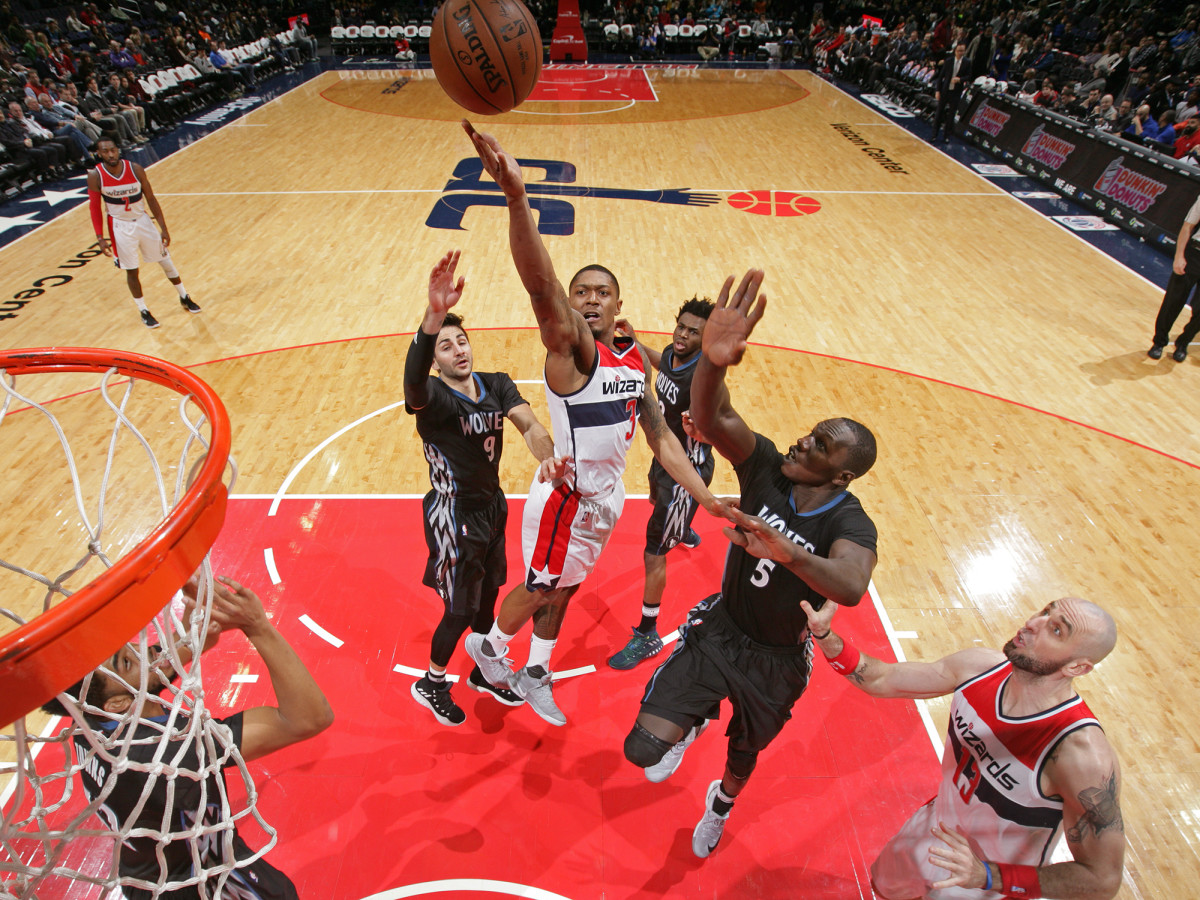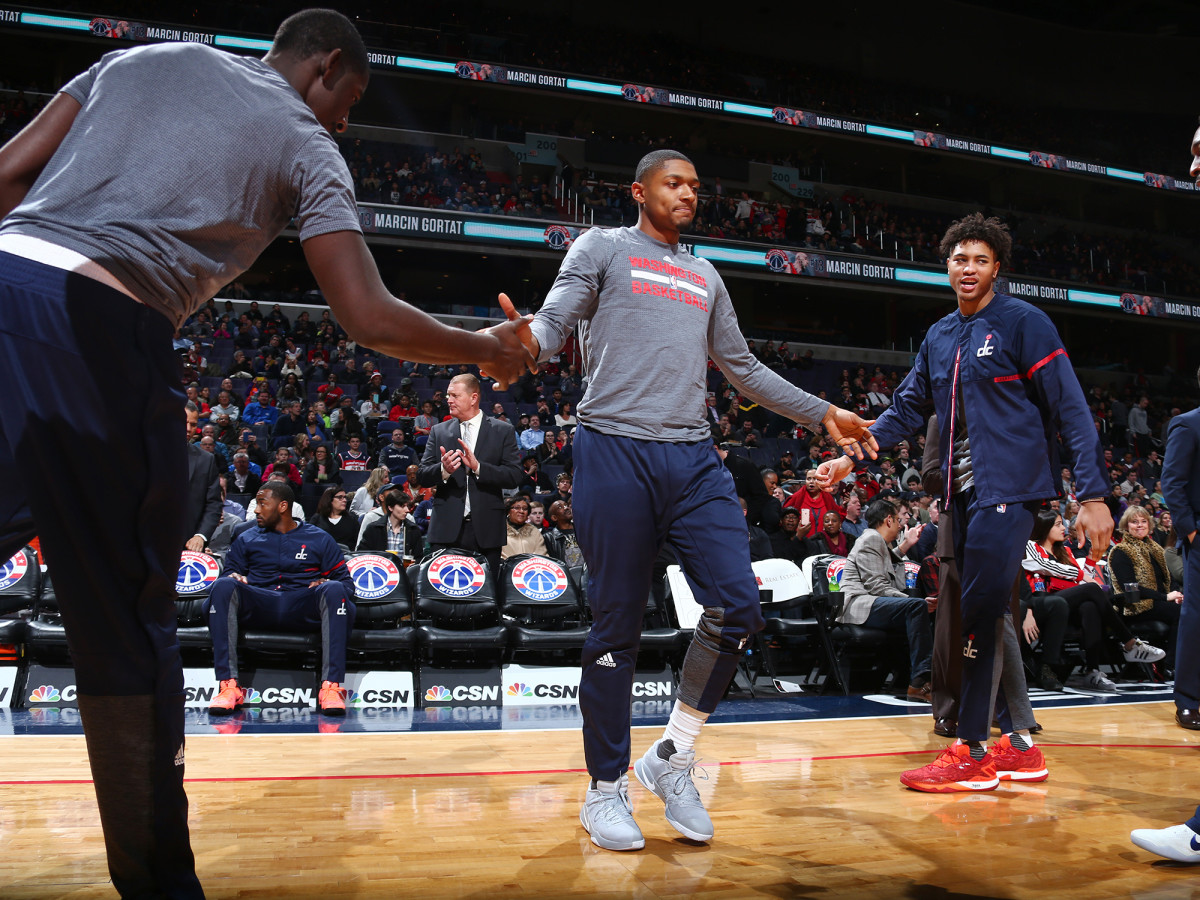Bradley Beal Changes Everything For The Wizards

For the first month of the NBA season, the Wizards had no bench, the stars had no chemistry, and there was not much flexibility for the future. The closer you looked, the darker it got. Even October's measured optimism looked ridiculous by the end of November. And to understand what changed since then—the Wizards have won nine of 13 games, and look suspiciously competent in the East—it helps to start at rock bottom.
The Wizards were on the road against OKC on Nov. 30th, and they were in control for most of the game. Russell Westbrook was off, the rest of the Thunder couldn't score, and the game was turning into a pleasant surprise for a D.C. team that badly needed it. Bradley Beal hit a three with five minutes to go in the fourth. It gave him 24 points on the night to lead all scorers, and Washington went up 7. From there, Markieff Morris went to the line twice and missed all four free throws, John Wall missed three shots, and the lead disappeared. Beal, hot all night, did not take a shot during this stretch. Westbrook was 7–of–28 from the field when he hit a three to send things to OT, and then he scored 14 points in overtime to win it.
NBA Stock Watch: Giannis, Zaza, Knicks, And The Power Of LeBron
game was another reminder that the team that lost Kevin Durant was still less depressing than the team that spent two years desperately chasing him.
But now that the Wizards are playing better and some of the existential dread has faded, the basic lesson from that game is clearer. It's the difference between the first three-and-a-half quarters and the final few minutes. When Bradley Beal plays well, the Wizards can compete with almost anyone. When Beal fades, the Wizards do, too.

This isn't all that complicated or insightful, but after the past two months, it's undeniable.
Even through the first month, Beal was the biggest reason those first few weeks were so brutal. He signed a five-year, $127 million deal over the summer, and then opened the year shooting 36% from the field through the first eight games. Then he got hurt again, and missed three games with a sprained ankle. The Wizards opened the year 2-8 through the first 10 games. For D.C. fans who were already freaked out by the Beal contract—not to mention the ensuing friction with Wall—it was the sum of all fears.
NBA All-Star Votes: Five Takeaways From The First Round Of Returns
But Beal came back, and he's playing the best basketball of his career. He's more aggressive than he's ever been, and smarter, too. Long, midrange twos have turned into threes, and he's getting to the line five times a game. He averaged 22 points per game on 46% shooting in December, and through four games in January, he's averaging 25 on 48% shooting. His defense has been solid on a nightly basis, and he's playing 34 minutes a game, and (mostly) staying healthy. It helps the Wizards in a few different ways.
First, Beal takes pressure off Otto Porter and Markieff Morris to be consistent second options. Both of them are good enough to help the offense on some nights, neither is good enough to help every night. But for the past six weeks, it hasn't mattered as much. With Beal attacking, big nights from Otto or Kieff have been a bonus, not a necessity for the Wizards to compete.
Likewise, when teams have to worry about guarding Beal out to the three-point line, it spaces the floor for everyone else. As he's gotten more comfortable attacking the lane on closeouts, he either gets to the line, or creates open looks. And the combination of excellent spacing with two guards who can create off the dribble is a big reason the Wizards are in the top five for clutch performance with a net rating of +8.6 among the starters.
Most importantly, and speaking of guards, Beal's emergence has helped Wall hit another level. Wall can be counted on for triple double-ish numbers regardless, but he's deadliest when he can pick his spots scoring and spend most of his time setting up teammates.
When Beal's struggling or injured, Wall's asked to do too much, and his game will fray at the edges. He'll settle for bad shots, sprint into dumb turnovers, and wear down defensively. We watched Wall live that timeline last year (when Beal started just 35 games). For the past six weeks, though, he's had enough help to pace himself. While Beal looks like an All-Star, Wall looks like an All-Star starter again—in December he put up 24.5 points, 10.5 assists, and 2.6 steals—and the Wizards are winning.

Now there are a series of questions that'll define the second half of the season in D.C. If the Wizards are respectable now, how good can they really be long-term with Wall and Beal? As we answer that question, should this season be graded on a curve because they're working with the worst bench in the league? If the Wizards have to pay Porter the max this summer, does it make sense to build around Beal, Wall, and Otto for the future? If they have to choose between Beal and Otto, what's the choice? Related: if they decide to commit $250 million to Beal and Porter, how does the team improve elsewhere?
Beal would have more value than Otto in the trade market, and he has injury questions that won't disappear after this year. He's also better than Porter, though, and the first real star that John Wall has played with in his entire career. He's only 23 years old, and there may be more room to grow. All of this makes Beal one of the most interesting players in the league this season. I'm not sure where this goes from here, but the Wizards looked dead six weeks ago, and now they're very much alive. I'm pretty sure Bradley Beal saved them.
